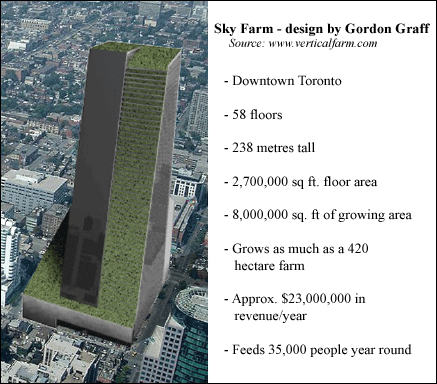Skyscraper farms?
A projected shortage in arable land; environmental degradation caused by chemical fertilizers; deforestation and desertification; biodiversity loss and other pressures brought by large scale industrial farming point to a system that is in need of change, he argues.
The solution is ‘vertical farming’, says Despommier, and his research is the most advanced in what has become a field of interest for many.
The Vertical Farm Project (www.verticalfarm.com) was established in 2001, and is managed at the Mailman School of Public Health at Columbia University in New York City. The research is ongoing, and has so far produced a detailed model of what an urban skyscraper farm would look like, with analysis showing positive economic and environmental results.
The group has determined that a single vertical farm, in the form of a 30 story building covering one square block, could provide enough food for 50,000 people per year using mostly existing technologies. The glass-walled building would host many levels of crops on each floor, from hanging tomatoes to standing grains to stacks of strawberries. Chickens could be raised for meat and eggs, as well as certain species of fish, though other livestock do not fit the model.
Temperature, light, plant feed and water would be controlled extensively, and renewable energy could be produced from a combination of wind and solar installations on the building and biomass consisting of agricultural waste.
Applying Despommier’s research, several designers and architects have sought to bring the idea to life, producing detailed plans including images and case studies. SkyFarm, a concept for Toronto, in theory could feed 35,000 people per year, produce $23,000,000 in revenue annually, and grow as much food as a 420 hectare farm.

Crops could be grown in high densities, with 1 indoor acre approximately equivalent to 4-6 outdoor acres, and much more in some cases. Strawberries, for example, can be stacked and increase the ratio to make 1 indoor acre equal to 30 outdoor acres.
In order to make the concept viable, Despommier stresses that ecological balance must be achieved. Food production will be organic, all waste material will be recycled, and the system could be used to filter urban wastewater for use in irrigation. The system will result in substantially less greenhouse gas emissions, by reducing the need for food transport and cutting out diesel-powered machinery used in industrial farming.
Increased urbanization of farming would also allow agricultural lands to be returned to their natural state of wetlands and forests, increasing their carbon storage potential and acting as a moderator of climate.
There are significant research challenges in biology, engineering, and urban planning still to be addressed, and the concept must receive strong government support, notes Despommier. In order to be successful, vertical farms must be affordable, durable, and able to show a profit without subsidy, he argues. A study conducted by his research group concludes that a well designed vertical farm could achieve returns comparable to the stock market, and would provide an attractive opportunity for institutional investors.
If these conditions are met, urban agriculture could be a significant source of food for the billions of people that will be living in cities worldwide by 2030, argue Despommier and others.
The use of indoor agriculture is currently widespread, as greenhouses are commonly used to grow hanging rows of tomatoes, berries, and other produce. Companies have developed a range of products based on the concept of increasingly urban indoor farming.
You can return to the main Market News page, or press the Back button on your browser.

